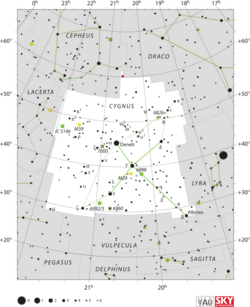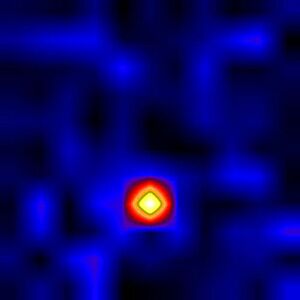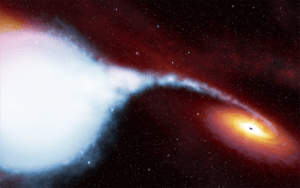Cygnus X-1 facts for kids
| Observation data Epoch J2000 Equinox J2000 |
|
|---|---|
| Constellation | Cygnus |
| Right ascension | 19h 58m 21.67574s |
| Declination | +35° 12′ 05.7845″ |
| Apparent magnitude (V) | 8.95 |
| Characteristics | |
| Spectral type | O9.7Iab |
| U−B color index | −0.30 |
| B−V color index | +0.81 |
| Variable type | Ellipsoidal variable |
| Astrometry | |
| Radial velocity (Rv) | −2.70±3.2 km/s |
| Proper motion (μ) | RA: −3.812±0.015 mas/yr Dec.: −6.310±0.017 mas/yr |
| Parallax (π) | 0.4439 ± 0.0149 mas |
| Distance | 7,300 ± 200 ly (2,250 ± 80 pc) |
| Absolute magnitude (MV) | −6.5±0.2 |
| Details | |
| Cygnus X-1 | |
| Mass | 21.2 M☉ |
| Details | |
| HDE 226868 | |
| Mass | 20–40 M☉ |
| Radius | 20–22 R☉ |
| Luminosity | 3–4×105 L☉ |
| Surface gravity (log g) | 3.31±0.07 cgs |
| Temperature | 31000 K |
| Rotation | every 5.6 days |
| Age | 5 Myr |
| Other designations | |
| Database references | |
| SIMBAD | data |
Cygnus X-1 (or Cyg X-1) is a very strong source of X-rays in space. It is found in the constellation called Cygnus, which looks like a swan. Scientists believe it was the first object proven to be a black hole.
It was found in 1964 during a rocket flight. Cygnus X-1 is one of the brightest X-ray sources we can see from Earth. It is still one of the most studied objects of its kind. The compact object in Cygnus X-1 is thought to be about 21.2 times the mass of the Sun. It is too small to be a normal star, so it is likely a black hole. If it is a black hole, its event horizon (the point of no return) is about 300 kilometers wide.
Cygnus X-1 is part of a two-star system. It orbits a huge blue star called HDE 226868. This system is about 2,220 parsecs (or 7,240 light-years) away from the Sun. The black hole orbits HDE 226868 at a distance of about 0.2 AU. This is about 20% of the distance from Earth to the Sun.
Gas from HDE 226868 flows towards the black hole. This gas forms a spinning disk around the black hole, called an accretion disk. The gas in this disk gets super hot, reaching millions of degrees. This extreme heat creates the X-rays we observe. The system also shoots out powerful streams of particles, called relativistic jets. These jets are aimed away from the disk.
This star system might be part of a group of stars called Cygnus OB3. If so, Cygnus X-1 is about 5 million years old. It likely formed from a star that was more than 40 times the Sun's mass. Most of that star's mass was lost, probably through a strong stellar wind. If the star had exploded as a supernova, the black hole would likely have been thrown out of the system. So, the star might have just collapsed directly into a black hole.
Cygnus X-1 was part of a friendly bet between famous physicists Stephen Hawking and Kip Thorne in 1975. Hawking bet it was not a black hole, hoping to lose. He gave up the bet in 1990. By then, more observations showed that it really was a black hole.
Contents
How Was Cygnus X-1 Discovered?
Scientists study X-ray light to learn about very hot gas in space. But Earth's atmosphere blocks X-rays. So, to see X-ray sources, instruments must go high above the atmosphere. Cygnus X-1 was found using X-ray tools on a sounding rocket launched in 1964. This rocket took off from White Sands Missile Range in New Mexico.
The rocket carried special detectors called Geiger counters. These detectors measured X-rays across a part of the sky. As the rocket spun, it created a map of X-ray sources. Cygnus X-1 (then called Cyg XR-1) was one of eight new X-ray sources found. At first, scientists did not know what star or object was making these X-rays.
To study X-ray sources for longer, NASA launched the Uhuru satellite in 1970. Uhuru found 300 new X-ray sources. Uhuru's observations of Cygnus X-1 showed that its X-ray brightness changed very quickly, several times a second. This rapid change meant the X-rays must come from a very small area. This area was no bigger than about 100,000 kilometers, roughly the size of Jupiter. This is because light cannot travel instantly between distant points.
In 1971, scientists detected radio waves from Cygnus X-1. They used the radio waves to pinpoint the X-ray source to the star HDE 226868. This star is a supergiant and is too big to make all those X-rays by itself. This meant it had to have a hidden companion. This companion would be heating gas to millions of degrees to create the X-rays.
In 1972, scientists found the hidden companion. They used the Doppler shift of the star's light to figure out its mass. The companion was very massive, too massive to be a neutron star. This led them to believe it was a black hole. By the end of 1973, most astronomers agreed that Cygnus X-1 was indeed a black hole. Later measurements showed X-ray changes in just a millisecond. This fits with gas swirling around a black hole.
Cygnus X-1 has been studied a lot since then. It is similar to other objects called active galactic nuclei. These are bright centers of galaxies that also have black holes. Because of this, Cygnus X-1 is called a microquasar. Studying Cygnus X-1 helps us understand these huge active galaxies.
The Cygnus X-1 Star System
Cygnus X-1 is a binary system. This means it has two main parts: a compact object (the black hole) and the huge blue star HDE 226868. They orbit each other every 5.6 days. From Earth, the black hole never passes behind the star. So, we do not see eclipses.
The system is about 2,220 parsecs (7,240 light-years) away from us. This distance was measured using parallax, which is how much an object seems to shift when viewed from different points. The orbit is almost a perfect circle.
The Cygnus X-1 system moves through space with a group of massive stars called Cygnus OB3. This group is also about 2,000 parsecs away. This suggests that Cygnus X-1, HDE 226868, and the OB association all formed at the same time. If so, the system is about 5 million years old.
The Black Hole
Scientists have used different ways to measure the mass of the compact object in Cygnus X-1. Its mass is much larger than the maximum mass a neutron star can have. Models suggest it is about 20 to 40 times the mass of the Sun. New measurements in 2021 estimated its mass to be 21.2 times the Sun's mass. This means it is almost certainly a black hole.
A black hole is a region in space where gravity is so strong that nothing, not even light, can escape. The edge of this region is called the event horizon. For Cygnus X-1, the event horizon has a radius of about 44 kilometers. Anything that crosses this boundary cannot get out.
In 1992, scientists might have seen evidence of an event horizon. They used the Hubble Space Telescope to look at ultraviolet light. When clumps of matter spiral into a black hole, they give off light in pulses. As the matter gets closer to the event horizon, the light's wavelengths stretch out. This is called gravitational redshift. If the matter hit a solid object, there would be a final burst of energy. But if it passes through an event horizon, there is no final burst. Scientists saw two "dying pulse trains" of light. This matches what we would expect from a black hole.
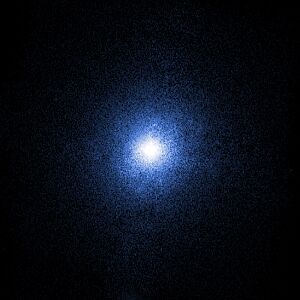
Scientists are still trying to figure out how fast the black hole spins. Some early data suggested it was not spinning much. But evidence from 2011 suggests it spins very fast, about 790 times per second.
How the Black Hole Formed
The largest star in the Cygnus OB3 group is 40 times the Sun's mass. Bigger stars evolve faster. So, the star that formed Cygnus X-1 was probably more than 40 times the Sun's mass. Since the black hole is now about 21 times the Sun's mass, the original star must have lost over 30 solar masses of material. Some of this mass might have gone to HDE 226868. The rest was likely blown away by a strong stellar wind.
If the original star had exploded as a supernova, the black hole would likely have been kicked out of the system. But Cygnus X-1 stayed in orbit. This suggests that the star might have collapsed directly into a black hole without a big explosion.
The Accretion Disk
The black hole is surrounded by a flat, spinning disk of gas and dust. This is called an accretion disk. The gas in the disk gets incredibly hot due to friction. Gas in faster inner orbits rubs against gas in slower outer orbits. This heats the gas to millions of degrees.
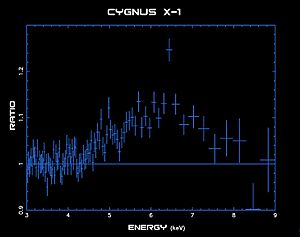
Cygnus X-1 is usually the brightest source of "hard" X-rays in the sky. Hard X-rays have higher energy. These X-rays are made when lower-energy light from the inner disk gets boosted in energy. This happens when it interacts with super-hot electrons in a cloud around the disk. This cloud is called a corona.
The X-rays from Cygnus X-1 can change in a repeating pattern called quasi-periodic oscillations (QPO). The mass of the black hole seems to affect where these QPOs start. This helps scientists estimate the black hole's mass.
Unlike neutron stars, Cygnus X-1 has never shown steady X-ray pulses. Neutron stars pulse because of their spinning magnetic fields. Black holes do not have this kind of magnetic field. Cygnus X-1 also does not show X-ray bursts like neutron stars do.
Cygnus X-1 changes between two X-ray states: "hard" and "soft." In the hard state, more X-rays have high energy. In the soft state, more X-rays have lower energy. The soft state also changes more. The hard state is thought to come from the corona around the disk. The soft state happens when the disk moves closer to the black hole.
The X-ray brightness of Cygnus X-1 also changes every 5.6 days. This happens especially when the black hole is behind the star from our view. This means that gas from the star HDE 226868 is partly blocking the X-rays. There is also a change in X-ray brightness every 300 days. This might be caused by the accretion disk wobbling.
Jets of Energy
As gas falls into the black hole, it loses gravitational energy. Some of this energy is released as powerful streams of particles called jets. These jets shoot out away from the accretion disk at speeds close to the speed of light. These jets help the accretion disk get rid of extra energy. They might be created by strong magnetic fields around the black hole.
The jets from Cygnus X-1 do not give off much light themselves. They appear "dark." One of the jets is hitting a thick cloud of gas and dust in space. This collision creates an energized ring that we can see with radio telescopes. This collision also forms a nebula that we can see with optical telescopes. To create this nebula, the jet must have a lot of power, more than 1,000 times the power of the Sun. The other jet is not hitting a thick cloud, so we do not see a similar ring.
In 2006, Cygnus X-1 was the first black hole of its size found to give off very high-energy gamma-rays. This happened at the same time as a burst of hard X-rays. This suggests a connection between the two events. The X-ray burst might have come from the base of the jet. The gamma rays might have been made when the jet hit the stellar wind from HDE 226868.
The Star HDE 226868
HDE 226868 is a huge star called a supergiant. Its surface temperature is about 31,000 K. It is about 20 to 40 times the mass of the Sun. Based on its distance, this star might be 15 to 17 times bigger than the Sun's radius. It is also 300,000 to 400,000 times brighter than the Sun. The black hole orbits HDE 226868 at a distance of about 40 solar radii, which is twice the size of the star itself.
The strong gravity of the black hole pulls on HDE 226868. This makes the star a bit tear-drop shaped. As the star rotates, its brightness changes slightly. This is why it is called an "ellipsoidal variable" star.
Like other stars of its type, HDE 226868 is losing mass through a stellar wind. This wind is like a constant stream of gas flowing away from the star. The black hole's gravity changes the shape of this stellar wind. X-rays from the black hole's region heat and ionize this stellar wind. As the black hole moves in its orbit, the X-rays and other light from the system change.
The Roche lobe is the area around a star where its gravity holds onto orbiting material. For HDE 226868, this area is close to its surface. The black hole is not pulling material directly off the star's surface. However, a lot of the stellar wind from HDE 226868 is pulled onto the black hole's accretion disk.
Gas and dust between the Sun and HDE 226868 make the star look dimmer and redder. If there were no dust, HDE 226868 would be bright enough to see with your eyes.
Images for kids
-
A blue-band light curve for Cygnus X-1, adapted from Kemp et al. (1987)
See also
 In Spanish: Cygnus X-1 para niños
In Spanish: Cygnus X-1 para niños
- X-ray binary
- List of nearest black holes
- Stellar black hole


